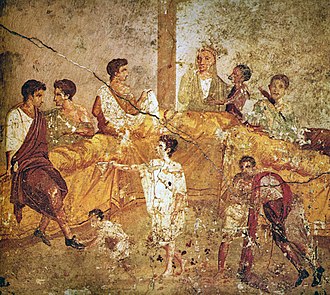
Back Kultuur van antieke Rome Afrikaans ثقافة روما القديمة Arabic Qədim Roma mədəniyyəti Azerbaijani Древноримска култура Bulgarian Cultura de l'antiga Roma Catalan Římská kultura Czech Romersk kultur Danish Römische Kultur German Kulturê Roma Antike DIQ Romia kulturo Esperanto
This article's lead section may be too long. (February 2023) |

The culture of ancient Rome existed throughout the almost 1,200-year history of the civilization of Ancient Rome. The term refers to the culture of the Roman Republic, later the Roman Empire, which at its peak covered an area from present-day Lowland Scotland and Morocco to the Euphrates.
Life in ancient Rome revolved around the city of Rome, its famed seven hills, and its monumental architecture such as the Colosseum, Trajan's Forum, and the Pantheon. The city also had several theaters and gymnasia, along with many taverns, baths and brothels. Throughout the territory under ancient Rome's control, residential architecture ranged from very modest houses to country villas, and in the capital city of Rome, there were imperial residences on the elegant Palatine Hill, from which the word palace is derived. The vast majority of Rome's population lived in the city center, packed into Insulae (apartment blocks).
The city of Rome was the largest megalopolis of that time, with a population that may well have exceeded one million people, with a high-end estimate of 3.6 million and a low-end estimate of 450,000. A substantial proportion of the population under the city's jurisdiction lived in innumerable urban centers, with population of at least 10,000 and several military settlements, a very high rate of urbanization by pre-industrial standards. The most urbanized part of the Empire was Italy, which had an estimated rate of urbanization of 32%, the same rate of urbanization of England in 1800. Most Roman towns and cities had a forum, temples and the same type of buildings, on a smaller scale, as found in Rome. The large urban population required an enormous supply of food, which was a complex logistical task, including acquiring, transporting, storing and distribution of food for Rome and other urban centers. Italian farms supplied vegetables and fruits, but fish and meat were luxuries. Aqueducts were built to bring water to urban centers and wine and oil were imported from Hispania, Gaul and Africa.
There was a very large amount of commerce between the provinces of the Roman Empire, since its roads and transportation technology were very efficient. The average costs of transport and the technology were comparable with 18th-century Europe. The later city of Rome did not fill the space within its ancient Aurelian Walls until after 1870.
The majority of the population under the jurisdiction of ancient Rome lived in the countryside in settlements with less than 10,000 inhabitants. Landlords generally resided in cities and their estates were left in the care of farm managers. The plight of rural slaves was generally worse than their counterparts working in urban aristocratic households. To stimulate a higher labor productivity most landlords freed a large number of slaves and many received wages, but in some rural areas poverty and overcrowding were extreme.[1] Rural poverty stimulated the migration of population to urban centers until the early 2nd century when the urban population stopped growing and started to decline.
Starting in the middle of the 2nd century BC, private Greek culture was increasingly in ascendancy, in spite of tirades against the "softening" effects of Hellenized culture from the conservative moralists. By the time of Augustus, cultured Greek household slaves taught the Roman young (sometimes even the girls); chefs, decorators, secretaries, doctors, and hairdressers all came from the Greek East. Greek sculptures adorned Hellenistic landscape gardening on the Palatine or in the villas, or were imitated in Roman sculpture yards by Greek slaves.
Against this human background, both the urban and rural setting, one of history's most influential civilizations took shape, leaving behind a cultural legacy that survives in part today.
The Roman Empire began when Augustus became the first emperor of Rome in 31 BC and ended in the west when the last Roman emperor, Romulus Augustulus, was deposed by Odoacer in AD 476. The Roman Empire, at its height (c. AD 100), was the most extensive political and social structure in Western civilization. By 285 AD, the Empire had grown too vast to be ruled from the central government at Rome and so was divided by Emperor Diocletian into a Western and an Eastern Roman Empire. In the east, the Empire continued as the Byzantine Empire until the death of Constantine XI and the fall of Constantinople to the Ottoman Empire in 1453. The influence of the Roman Empire on Western civilization was profound in its lasting contributions to virtually every aspect of Western culture.
- ^ For example, a Romano-Egyptian text attests to the sharing of one small farmhouse by 42 people; elsewhere, six families held common interest in a single olive tree. See Alfoldy, Geza., The Social History of Rome (Routledge Revivals) 2014 (online e-edition, unpaginated: accessed October 11th, 2016)